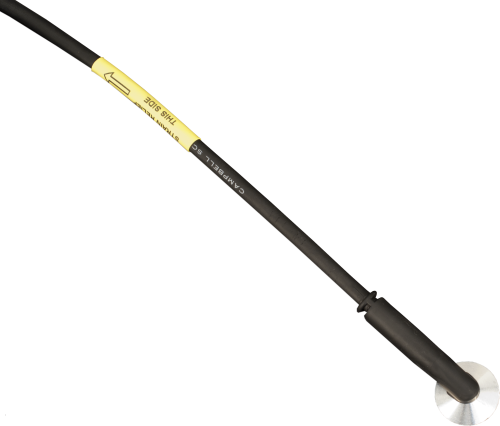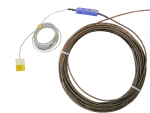
| Services Available | |
|---|---|
| Repair | No |
| Calibration | No |
| Free Support | Yes |
Overview
The 110PV is a thermistor that measures the temperature of a surface by direct contact. It typically monitors the temperature of a photovoltaic module, but can also monitor the temperature of other devices. This thermistor easily interfaces with our dataloggers, and is ideal for solar energy applications.
Read MoreBenefits and Features
- Measures temperature across a wide range: -40° to +135°C
- Easy to install—adhesive strips on the 110PV’s smooth face adhere to the back of a solar panel or other device
- Aluminium disk protects thermistor and promotes heat transfer from surfaces
- Makes accurate measurements in environments with heavy electromagnetic interference
- Compatible with the CWS900-series interfaces, allowing it to be used in a wireless sensor network
Technical Description
The 110PV consists of a thermistor encased in an aluminium disk. The disk protects the thermistor and promotes heat transfer from surfaces. An adhesive tab on the probe’s aluminium disk fastens the 110PV to the measurement surface. If the temperature may exceed 70°C, Kapton tape is also required to secure the probe; Kapton tape is offered as a Common Accessory (see Ordering Info). Note: Campbell Scientific does not recommend using epoxy to secure the 110PV to a PV module.
The 110PV can provide the photovoltaic (PV) module temperature for solar energy applications. This measurement is useful because the output of a PV module is affected by its temperature. As the temperature of the PV module increases, its output decreases.
Images




Compatibility
Please note: The following shows notable compatibility information. It is not a comprehensive list of all compatible products.
Dataloggers
| Product | Compatible | Note |
|---|---|---|
| CR1000 (retired) | ||
| CR1000X (retired) | ||
| CR200X (retired) | ||
| CR216X (retired) | ||
| CR300 (retired) | ||
| CR3000 | ||
| CR310 | ||
| CR5000 (retired) | ||
| CR6 | ||
| CR800 (retired) | ||
| CR850 (retired) | ||
| CR9000X (retired) |
Additional Compatibility Information
Mounting
For temperatures up to 70°C, an adhesive tab on the probe’s aluminum disk fastens the 110PV to the measurement surface. If the temperature may exceed 70°C, Kapton tape is recommended to secure the probe to the measurement surface. Kapton tape is available from Campbell Scientific (see Ordering Information).
The 110PV can be submerged to 50 ft, but the probe’s adhesive tab is not intended for submersion. Therefore the 110PV must be mounted to the measurement surface via a user-supplied method that is compatible with submersion.
Data Logger Considerations
Programming
The CR200(X)-series dataloggers use the ExDelSe instruction to measure the 110PV. The CR800, CR850, CR1000, CR3000, CR5000, and CR9000(X) can use either the BrHalf4W instruction or BrHalf instruction to measure the 110PV. For these data loggers, the BrHalf4W instruction is typically preferred because it reduces cable errors. The BrHalf instruction requires fewer input channels.
In Edlog, Instruction 5 is typically used to measure the 110PV. The ratio metric output is then converted to resistance and finally to temperature.
Specifications
| Sensor | Thermistor with specially designed protective aluminum disk |
| Measurement Description | Back-of-module temperature |
| Operating Temperature Range | -40° to +135°C |
| Temperature Survival Range | -50° to +140°C |
| Temperature Uncertainty |
|
| Sensitivity | +1°C |
| Steinhart-Hart Linearization Equation Error | 0.0024°C (at -40°C) maximum |
| Disk Material | Anodized aluminum |
| Cable Jacket Material | Santoprene |
| Cable/Probe Connection Material | Santoprene |
| Maximum Lead Length | 304.8 m (1000 ft) |
| Disk Diameter | 2.54 cm (1.0 in.) |
| Probe Length | 6.35 cm (2.5 in.) |
| Overmolded Joint Dimensions | 5.72 x 1.12 x 1.47 cm (2.25 x 0.44 x 0.58 in.) |
| Weight | 90.7 g with 3.2-m cable (0.2 lb with 10.5-ft cable) |
Resources and Links
Product Brochures
Manuals
Listed Under
FAQs for
Number of FAQs related to 110PV: 16
Expand AllCollapse All
Articles and Press Releases
Privacy Policy Update
We've updated our privacy policy. Learn More
Cookie Consent
Update your cookie preferences. Update Cookie Preferences


